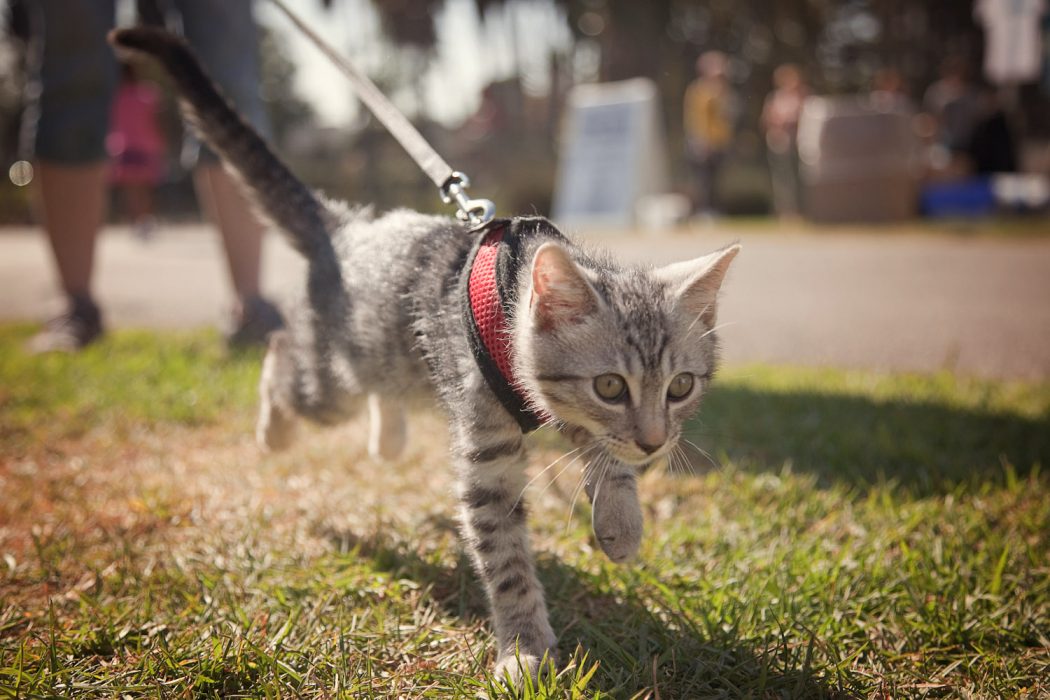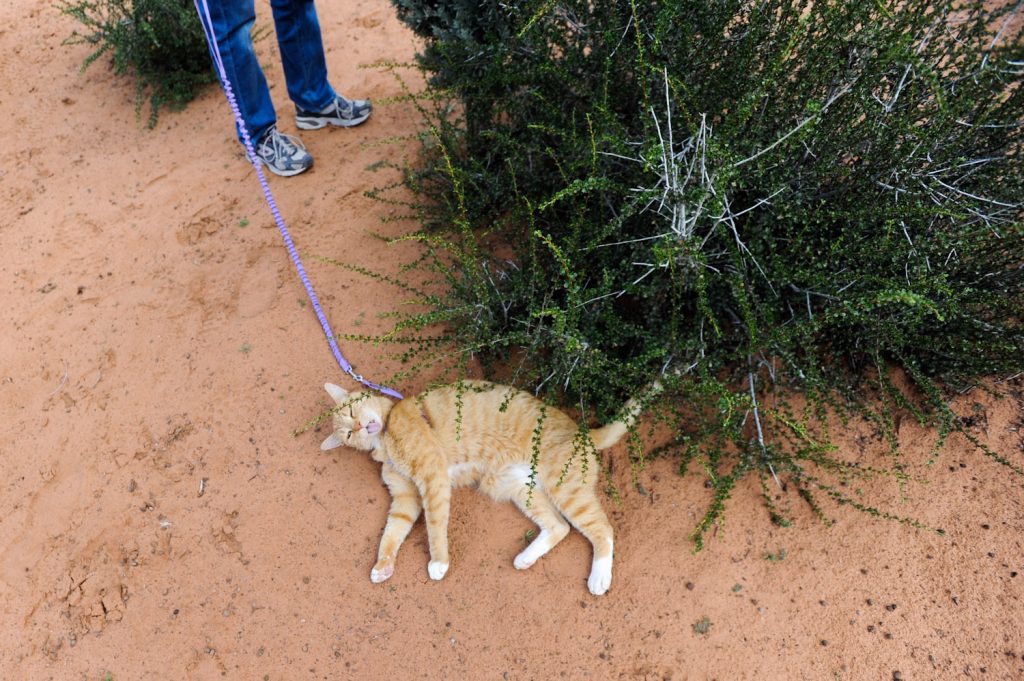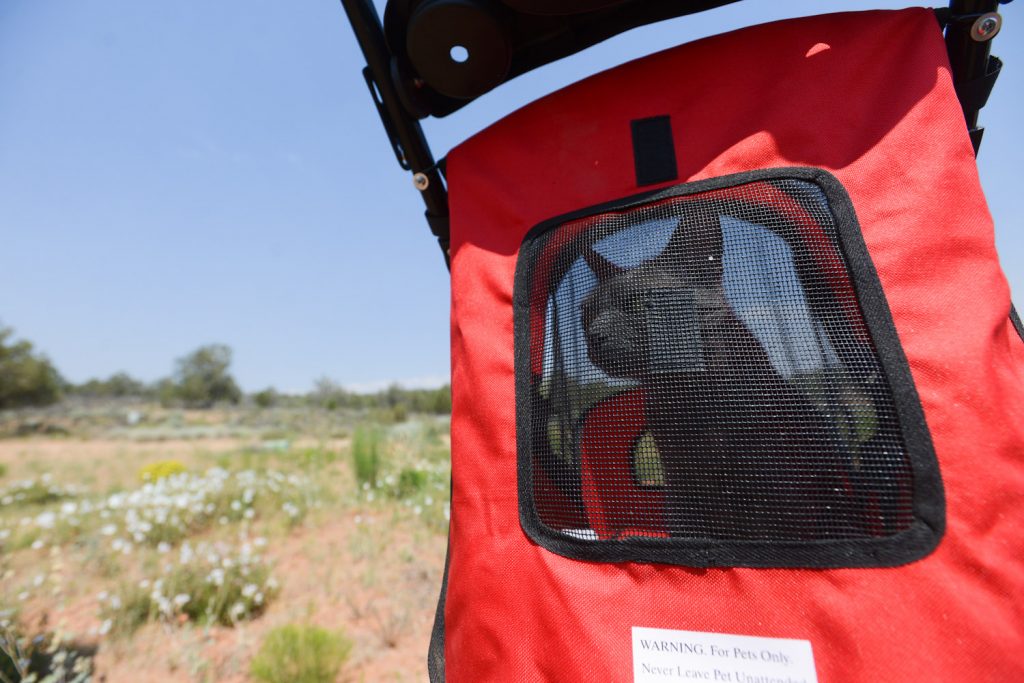With hundreds of cats in need of daily enrichment and thousands of acres of red-rock Utah land just waiting to be explored, the cat-hiking program at Best Friends Animal Society was a natural development. And it all started with Bob.
Bob, a black-and-white special-needs kitty, was the first feline at the sanctuary to take to a harness and leash. For years, he’d don his harness and wander up to various buildings at Cat World, meow at the door and wait for a treat — a routine his caregivers called “trick-or-treating.” Bob has since been adopted, but his legacy lives on at the nation’s largest no-kill sanctuary because he was a big “inspurration” for Best Friends’ cat-hiking program, which began six years ago.
“We had Bob who had been walking on a harness and leash for several years, and my personal cat walks on a harness and leash,” said Michalle Warfle, a former aerospace engineer who now manages Cat World. “I saw how much they both enjoyed the experience and I was looking to expand our enrichment program. So I made it a priority to get cats out for walks.”
Cats are social animals, as well as predators that aren’t that far removed from their wild ancestors, so they require enrichment activities that allow them to express natural behaviors.
“Walking on a harness and leash out of their building provides huge enrichment for the cats,” Warfle said. “It gets the cat outdoors to exercise all their senses on new things. Given that we are a sanctuary and many of our cats will live the remainder of their life here, enrichment is critical to ensuring quality of life.”
Cats that don’t receive enough mental stimulation may suffer from boredom, which can result in behavioral problems. However, regular playtime, clicker training or even some outdoor exploration time can often help alleviate these problems.
Warfle says that Princess Blue, a 14-year-old Russian Blue, is “a good example of harness walking benefiting the cat emotionally.”
“She needs a lot of activity,” she said. “Otherwise her litter box habits become less than desirable. She took to harness walking almost immediately. She loves to walk, explore. When she gets a walk once or twice a day, her litter box habits are perfect.”
In addition to the emotional and behavioral benefits that leash walking provides, Best Friends also uses its cat hikes as a way to keep its felines physically active and healthy. And for some kitties, such exercise is critical for pain management and mobility. For example, cats with Manx syndrome benefit from regular walks because it keeps their muscles in good shape.
But with 500 to 600 cats to care for, how do Cat World staff and volunteers manage to leash train them? The same way you leash train your own cat: one step at a time with lots of positive reinforcement.
“We put the harness on the cat and let them wear it inside while they are going about their normal routine,” Warfle said. “We will do this until they seem comfortable with it on. If they fall over or act like the harness is too heavy for them to carry, I will pull out a favorite wand toy and start playing with them. Soon the cat forgets he/she has anything on.”
However, just because a cat is leash trained doesn’t necessarily mean he or she is going to cover great distances. Warfle says that some of the cats, including her own leash-trained kitty, will walk for miles while others prefer to simply curl up in a sun puddle for a catnap.
“Our cats who walk on a harness go from one end of the spectrum to the other end when it comes to how far will they walk,” she said. “Some cats walk out of the building, find a sunny sanding spot, and lay down or roll around. Then they are done. Other cats will take the caregiver or volunteers exploring for hours.”
Of course, not all of Best Friends’ cats take to a harness, but luckily, even these kitties can still enjoy the great outdoors. Each of the sanctuary’s felines has access to a screened-in patio, and more than 100 of them also enjoy regular stroller rides.
“All of our cats who are not human fearful get tested for stroller rides,” Warfle said. “We assess how the cat is just sitting in the stroller. If they don’t get stressed and seem to enjoy the experience, they go on an approved list for stroller rides. Our strollers have several windows for the cats to look at the surrounding environment. Cats who don’t like to walk far on a harness seem to love stroller rides.”
Don’t have a cat of your own but eager to take one on a walk or ride? Volunteer at Cat World and make a sanctuary kitty’s day. (We’ve done it, and it’s ameowzing!)
Better yet, adopt one of these special cats and you’ll never hike alone. Warfle says they’ll even send the harness along with the cat.
[separator type=”thin”]
Photos courtesy of Best Friends Animal Society and Cody Wellons.








